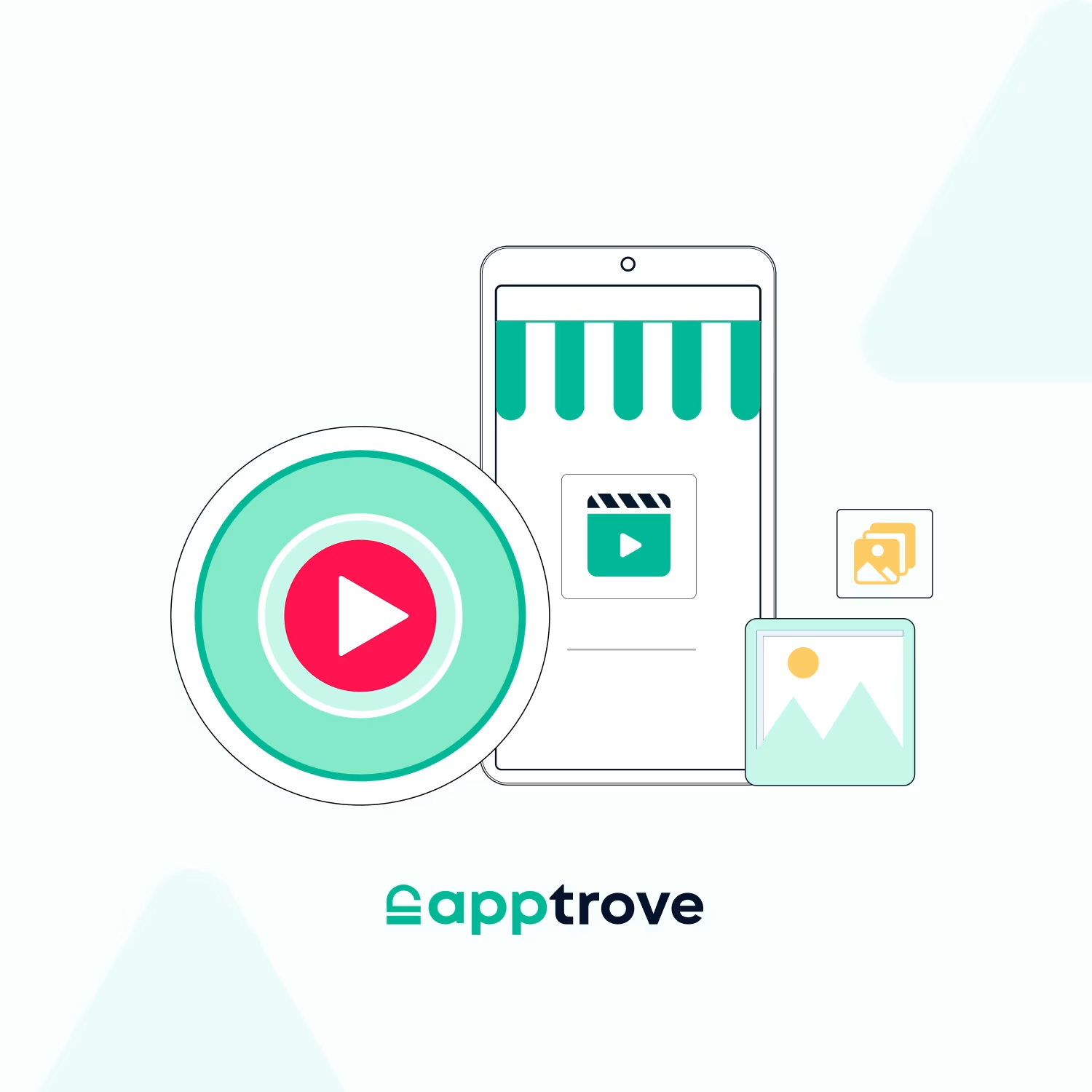Introduction
In today’s privacy-first mobile environment, creative has emerged as the most controlled and impactful lever in user acquisition (UA) strategy. With the decline of granular targeting and deterministic attribution, you’re likely shifting focus from “who to target” to “what to show.” The creative, not the audience, is now your key differentiator in effective mobile app marketing.
Over the past two years, this shift has accelerated dramatically. According to Statista, global mobile app installs and ad spend are projected to surpass $870.85 billion by 2027, yet you’re probably noticing that cost per install (CPI) is rising across both iOS and Android platforms. This market pressure is forcing you to find new efficiencies, and all indicators point toward creative optimization as your best opportunity.
Key Creative Insights You Can’t Ignore
Video-first creatives will give you dominance on TikTok, Meta, and YouTube, especially when you localize content and keep it under 15 seconds.
You’ll face ad creative fatigue quickly. Your highest-performing ads typically peak within 7-10 days unless you implement versioning or rotation strategies powered by mobile marketing automation.
Your iOS vs Android approach should differ. You’ll find iOS users respond better to utility-focused or benefit-driven messaging, while your Android campaigns will trend toward entertainment and feature depth.
Don’t abandon static creatives, but ensure they’re part of a broader mix including dynamic formats for best results, especially when aligned with your App Store Optimization (ASO) strategy.
You’re likely experiencing growing performance blind spots due to SKAN and Privacy Sandbox, making creative one key signal for understanding post-install behavior and optimizing user acquisition strategies.
Why This Matters to You
In your world of limited tracking and tighter budget, creative remains one of the few areas your UA team can actively control, test, and optimize. The right ad can cut your CPI by half or double your ROAS, while the wrong one can drain your budget before an algorithm ever finds your audience.
But great creativity doesn’t happen by chance. You’ll need:
- A clear testing framework you can implement consistently
- Smart unitization of platform-specific tools at your disposal
- Alignment with market trends, user psychology, and cultural nuances relevant to your audience
What You Can Implement Today
- Audit your creative mix: Are you over-relying on one format or recycling assets too frequently? This can accelerate ad creative fatigue nd stunt campaign growth.
- Build rapid interaction loops into your workflow: Test small variations frequently, and be willing to kill underperformers early.
- Leverage your post-install metrics: With attribution gaps widening, metrics like retention and session length can help you uncover which creatives drive long-term value and support your App Store Optimization (ASO) efforts indirectly.
- Adapt your approach by platform: Your TikTok creative shouldn’t look like your ASA screenshot or your YouTube bumper. Take into account different engagement patterns between iOS and Android.
Consider this report your blueprint for creative optimization in a fragmented, privacy-constrained ecosystem. Whether you’re managing mobile app installs, leading mobile app marketing initiatives, or developing performance creative strategy, you’ll find practical approaches, relevant benchmarks, and implementation frameworks throughout to guide your decision-making.
Let’s explore what’s working, what’s evolving, and how you can make creative the most reliable growth engine in your app marketing arsenal.
Introduction: The Creative Arms Race in Your Mobile UA Strategy
A quiet revolution is transforming how you approach mobile app marketing, and creativity is leading the charge. What you once viewed as a complementary piece to audience targeting and budget scaling has now become the centerpiece of your paid user acquisition (UA) strategy.
As granular tracking becomes increasingly limited, what your audience sees has become far more important than who your audience is. Why this shift? Platform-level privacy changes have made behavioral signals harder for you to access, and algorithmic targeting now favours inputs it can actually interpret, like your ad creative.
Your Journey From Targeting to Storytelling
For years, you could rely on high-precision targeting and real-time attribution to fine-tune your campaigns. But with Apple’s introduction of App Tracking Transparency (ATT) and the evolving SKAdNetwork (SKAN) framework, followed by Google’s Privacy Sandbox for Android, your familiar approach has been completely transformed.
- SKAN strips away the user-level granularity you’re accustomed to, offering only aggregated and delayed data for your post-install events.
- Android’s Privacy Sandbox, still rolling out, will eventually follow a similar path, prioritizing user privacy over the pinpoint campaign tracking you’ve come to expect.
In this new environment you’re navigating, creativity has become the strongest signal you have left.
Every second of your ad, from visual style to call-to-action, now influences algorithmic delivery, engagement rates, and ultimately, the mobile app install volume and quality you achieve.
Explore Apptrove’s SKAN Analytics Page and download our Getting SKAN 4.0 Right: A Practical Guide for Marketers for complete implementation details
How iOS and Android Impact Your Creative Strategy
While both platforms are embracing privacy-first frameworks, your creative testing approach needs to adapt differently depending on the OS you’re targeting:
On iOS, you’re dealing with SKAN’s Limited windows and conversion values. This makes your early creative performance (like taps, installs, and Day 1 retention) even more critical, since the long-term signals you need are harder to attribute.
On Android, you still have more visibility, for now, but future updates will limit your tracking fidelity. Your creative effectiveness will soon face the same pressure, requiring you to focus more deeply on pre-install signals and predictive metrics.
Regardless of which platform you’re prioritizing, creative has become your most agile, testable, and scalable lever in today’s UA environment. The result? You’re now part of a new kind of arms race, not of budget or bids, but of creativity, speed, and iteration.
Welcome to Your Era of Rapid Creative Testing
Your success today depends on how quickly and effectively your team can:
- Develop creative hypotheses that resonate with your target users
- Launch platform-tailored assets that speak to each audience
- Analyze early signals (CTR, IPM, CVR) to make informed decisions
- Rotate and iterate before creative fatigue impacts your performance
This isn’t about finding “one brilliant idea” and riding it to success. It’s about building systems that help you generate, test, and learn from a constant stream of ideas, across formats, languages, and platforms that matter to your growth.
The old playbook of “set and scale” that you might have relied on is no longer viable. What you need now is a continuous loop: test, analyze, iterate, repeat. Your creative approach has evolved into both a growth engine and a learning engine, revealing not just what converts for you but what truly resonates with your users.
As you work through this report, you’ll discover the anatomy of high-performing creatives, the frameworks that drive efficient testing for testing like yours, and the data-driven decisions that transform your creative into scalable asset, all while adapting to a rapidly evolving ecosystem where privacy and performance aren’t at odds, but working together.
The Anatomy of High-Performing Mobile Ad Creatives
In the competitive environment of mobile advertising, your creative assets have become the defining factor between breakthrough performance and disappointing results.
With audience targeting becoming less precise and attribution windows getting muckier in your campaigns, the visual story your ad tells is what truly moves the needle for your results. But high-performing creative isn’t just about good design, it’s about knowing what works, where it works, and why it resonates with your users.
Creative Formats That Will Drive Your Results
Your mobile users scroll fast. You have a second, maybe two, to catch their attention. That’s why picking the right format matters for your success. Here are the formats you should consider, and what they’re most effective for:
Static Image: Clear, simple, and still effective for your campaigns, especially when you pair them with bold messaging. Think of using these for quick retargeting reminders or when you’re spotlighting a new feature.
Video Ads: If static is a whisper, video is the shout you need. These dominate on platforms like TikTok, YouTube, and Meta, where your audience spends time. The best ones you’ll create tell a mini story in under 15 seconds and get right to the point your users care about.
Playable Ads: These are gold for your gaming and interactive apps. When you let someone “try before they install,” you build and often convert more loyal users for your app, driving meaningful mobile app installs.
Carousel Ads: Perfect when your app has multiple features or e-commerce offerings you want to showcase. Swipeable cards let you show benefits or product highlights in sequence, giving your users a comprehensive view.
Banner: Not flashy, but they still have their place in your strategy, particularly on programmatic or display networks. Think of these for your brand visibility or awareness campaigns.
Static vs. Dynamic Creatives- What’s Your Best Move?
Sometimes, you want total control over your message — one image, one message, delivered exactly as you planned. That’s where static creatives will serve you best.
But when you’re running multi-country campaigns or scaling fast, dynamic creatives (DCO) help you mix and match headlines, visuals, and calls to action on the fly. Platforms like Meta or Google UAC will automatically figure out the best combinations for your goals.
Our recommendation? Use dynamic for testing at scale, but keep refining static assets when you need brand consistency and storytelling control.
One Size Doesn’t Fit All: Your Platform-Specific Strategy
The same creative won’t perform equally across platforms for your campaigns, and tweaking your assets for where they show up is one of the easiest wins you can achieve.
Meta (Facebook & Instagram): Keep it native, polished but not overly produced for your audience. Hook your viewer in the first few seconds. Your text overlay should be light — think less than 20%.
TikTok: This is UGC territory for you. Think organic, lo-fi, fast-paced content. Use music, movement, and jump cuts in your creatives. It should feel like content your users would create, not an ad you’re pushing.
YouTube: Make your point early, especially for your skippable ads. Mobile-first design wins for your campaigns (yes, vertical is fine now). Clean audio and subtitles are a must for your viewers.
Snapchat: Vertical, full-screen video is the standard you should follow. Story-like sequencing works best for your content. AR or filters can boost interaction with your ads.
Apple Search Ads (ASA): Focus on screenshot quality and app previews that represent your app accurately. Match your creative to the user’s search intent. Including ratings and reviews in your screenshots? That’s a big trust builder for your conversions.
Curious how to go beyond the basics and actually win with ASA? Here’s our step-by-step guide to mastering Apple Search Ads — filled with insights to help you drive real results.
Let’s Talk Numbers: Benchmarks You Should Watch
Here’s a bird’s-eye view of how these formats tend to perform based on aggregated public data. Treat these as helpful reference points for your planning; your results may vary based on your category, targeting, and, of course, the creative quality you deliver.
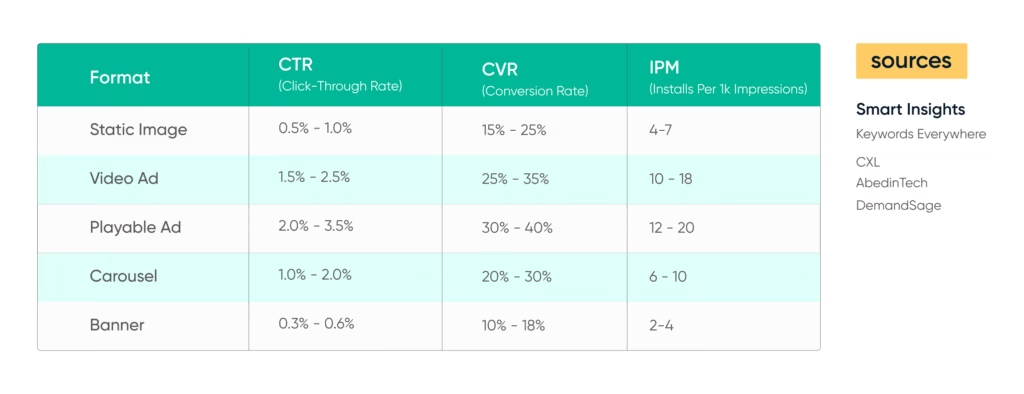
These numbers aren’t set in stone for your campaigns; they’re shaped by your audience, creative quality, timing, and even seasonality. But they do give you a sense of where to aim and what you can expect from your efforts.
So, What’s Your Takeaway?
Video and playable ads should be your priority, especially when attention spans are short and competition is high in your market.
Use carousel and static creatives as your support players — they’re excellent for storytelling and retargeting your existing audience.
Your creative should match the mood and behavior of each platform where you advertise. What works for you on YouTube might flop on TikTok.
Keep your eye on the metrics that matter for your success: CTR for scroll-stopping power, CVR for message clarity, and IPM for how well your creative converts at scale.
And remember: what worked for you last month might not work next week. The best-performing teams are the ones who test fast, learn fast, and treat their creatives as living, breathing assets, not one-off deliverables you create and forget.
Next, we’ll walk you through the playbooks and frameworks that top teams use to optimize, iterate, and stay ahead of the creative fatigue that can impact your performance.
Creative Optimization Frameworks & Best Practices
By now, it’s clear to you: creative can make or break your mobile UA strategy.
But here’s what you need to understand: even your best-performing creatives don’t stay great forever. What delivered results for you last month may be stale today. That’s where your creative optimization approach becomes critical.
Think of this as building a system for your team, not executing a single act. It’s not about you throwing a few versions into the mix and hoping for the best. It’s about you building repeatable loops of testing, learning, and improving that consistently drive your performance forward. Let’s unpack what this looks like when you implement it effectively.
Your A/B Testing Mindset: Constant Iteration > One-Time Winners
A/B testing remains the workhorse of your creative improvement process — and for good reason. It helps you remove guesswork and shows you what actually moves the needle for your campaigns.
Here’s how you can make it work for your strategy:
Test one variable at a time: If you change your headline, background, and CTA all at once, how will you know what drove your success?
Run with sufficient scale: Too small a test group for your campaigns? Your results might just be noise. You should aim for statistical significance before calling a winner.
Don’t ignore your losers: Knowing what didn’t work is just as useful for your learning. Was it the format? The messaging? You need to dig deeper.
Start with big swing variables (like concept or format), then drill down to fine-tuning details (like color palette or CTA text) that matter to your audience.
Your Versioning Strategy: One Concept, Many Angles
Once you’ve identified a winning concept, don’t stop there; that’s your signal to build versions for maximum impact. Keep the same core idea, but adapt it for:
- Different platforms where your users spend time
- Different audience segments you’re targeting
- Different languages or regions you’re expanding into
This approach lets you scale your successes without reinventing the wheel each time.
For example, if your video ad featuring a workout challenge performs exceptionally well for you on TikTok, try creating a vertical remix with a new soundtrack for Reels, and a static teaser for your Meta Stories campaigns. Keep the core message that resonated, just change the flavor for each platform.
Creative Fatigue is Real (and Sneaky) for Your Campaigns
Even your top-performing creative has an expiration date that you need to monitor.
Creative fatigue happens when your users have seen your ad too often. Your performance drops, CTR dips, installs slow down — but your spend keeps increasing.
Here’s how you can spot it in your campaigns:
- Your CTR drops by more than 26% week-over-week
- Your IPM falls, but impressions keep rising
- Your ROAS starts slipping, even though targeting hasn’t changed
To address this, you should rotate fresh variations regularly and use tools (including Apptrove’s dashboards) to monitor creative lifecycle data across your campaigns.
Localization: Your Creative Isn’t Universal
Localizing your creatives goes far beyond just translating your CTA. You need to understand cultural context, visual preferences, and even the humor that resonates with each market.
What works for your U.S. audience might feel too aggressive in Japan. A fast-paced, energetic video might crush your performance in Brazil, but feel completely off-brand in Germany.
Your localization best practices should include:
- Using local creators or agencies to create market-specific assets for your campaigns
- Adapting visuals and symbols (colors, hand gestures, fonts) that matter to your audience
- Reflecting local values (family vs. individualism, minimalism vs. boldness) in your messaging
Even something as simple as switching your CTA from “Buy Now” to “Discover More” can shift perception and performance in different regions.
Your Channel-Specific Creative Customization Strategy
Different channels require different approaches for your success. Instead of repurposing the same ad across platforms, you should adapt for native behavior:
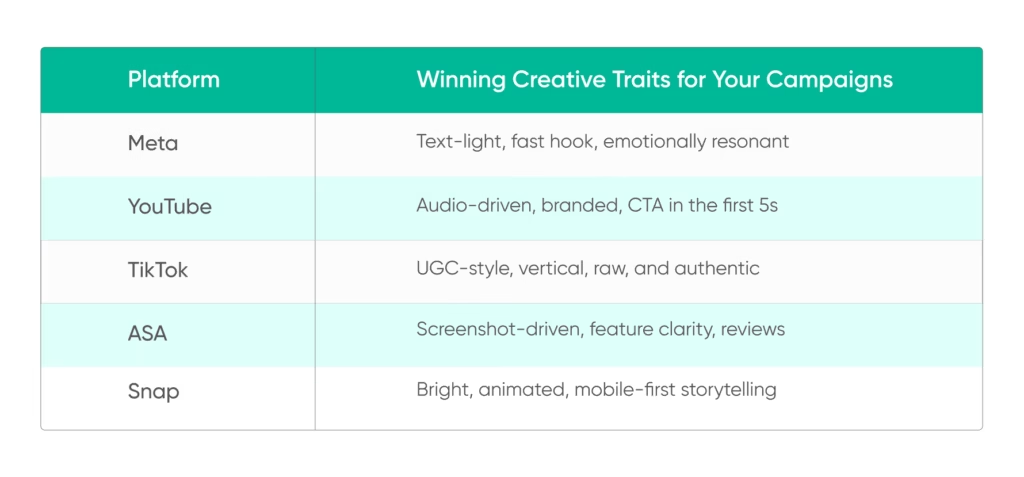
When in doubt, observe how your users behave on each platform, then design creatives that feel like a natural part of that experience.
Your Optimization Checklist
Before moving into your next sprint, ask yourself:
- Are you running tests with clear hypotheses that will inform your strategy?
- Are you tracking creative fatigue and replacing stale assets before they hurt performance?
- Are you versioning based on platform, segment, or region to maximize relevance?
- Are you letting performance data — not gut feelings — guide your decisions?
If you answered “not yet” to any of those questions, you’re leaving easy wins on the table that could significantly improve your results.
Next, we’ll explore how you can make data your creative co-pilot — from SKAN postbacks to retention metrics — and how to interpret what’s actually working for your long-term success.
Data-Driven Creative Decisions
Your creative instincts are valuable. But in mobile UA? Data becomes your true creative partner.
The best-performing teams don’t just guess what works for their campaigns — they measure it, iterate, and build a feedback loop that turns performance signals into smarter creatives over time. Let’s break down what it means for you to truly make creative decisions that are data-backed, not gut-driven.
Beyond the Install: Why Post-Click Metrics Matter for Your Strategy
It’s tempting for you to judge a creative by its CTR or IPM. But in today’s privacy-first world, volume-based metrics are just the first layer of what you need to understand.
If you’re optimizing for long-term ROI, you need to ask yourself:
- Did your ad drive a quality user or just a curious clicker?
- Did the install lead to engagement, purchases, or retention for your app?
- How did this creative perform on SKAN or Privacy Sandbox frameworks that affect your attribution?
Here’s a hierarchy of creative performance metrics you should prioritize:
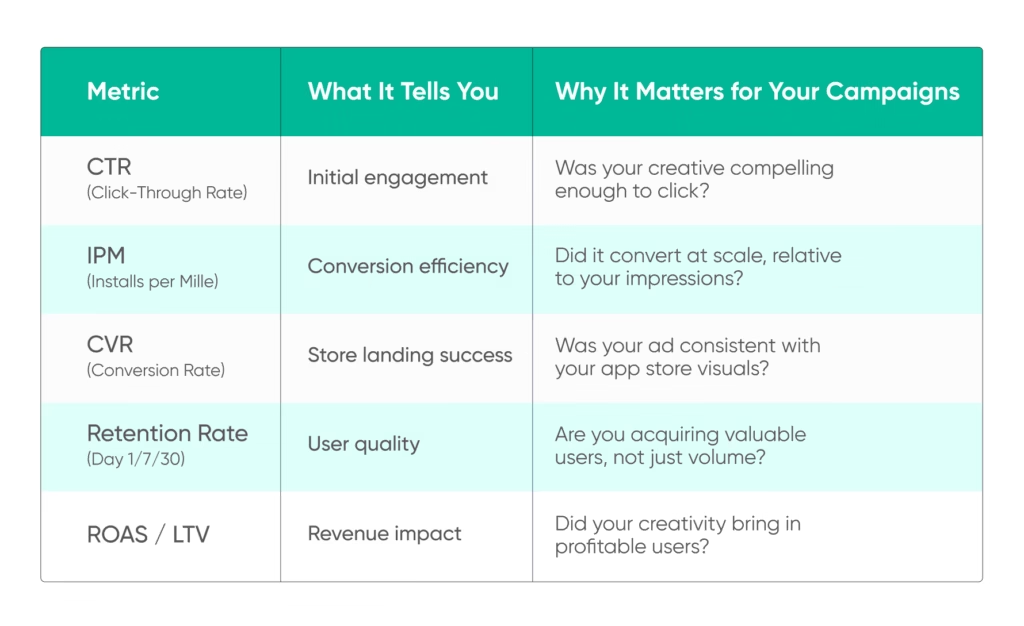
The Attribution Puzzle: Making Sense of SKAN and Privacy Sandbox for Your Campaigns
Attribution isn’t what it used to be for your tracking needs. With the shift to SKAdNetwork on iOS and the gradual rollout of Privacy Sandbox on Android, your UA team is working with more aggregated and delayed signals.
Here’s how you can adapt your approach:
Match your creatives with conversion values: On iOS, SKAN postbacks can include anonymized conversion signals. Make sure you’re mapping your specific creatives to revenue events that matter.
Group your creatives into cohorts: Instead of tracking individual assets, cluster your creatives into thematic buckets (like tutorial-focused vs. cinematic) and compare performance by cohort.
Use time windows wisely: SKAN gives you only a short attribution window, so you need to measure early engagement metrics carefully.
Want a deeper breakdown of how SKAN works (and how to actually make it work for you)? Check out our complete guide to SKAN attribution — everything you need to know, simplified.
Cohort Analysis: Your Secret Weapon for Creative Validation
Let’s say your new video ad has a 2.2% CTR and a solid IPM. That’s promising for your initial metrics, but what about the quality of users you’re acquiring?
You should use cohort analysis to track how users acquired by each of your creatives behave over time:
- How many open your app on Day 1? Day 7?
- What’s their in-app event completion rate (sign-up, level complete, purchase)?
- What’s the Day 7 ROAS you’re seeing from this creative?
A strong creative should show early retention lift for your campaigns, not just top-of-funnel performance. This is especially important with SKAN’s limited postback window, where only early indicators are visible to you.
Use Apptrove to layer your creative IDs into cohorts and track meaningful downstream actions that impact your bottom line. See how FoodHub navigated similar attribution challenges while maintaining creative performance visibility in our detailed case study.
Your Visual Workflow: From Postbacks to Creative Insights
Understanding SKAN postbacks doesn’t have to be intimidating for your team. Here’s a simplified flow to help you go from data → insights → your next creative version:
Your Creative A (Install) → SKAN Postback (D1 event value) → MMP Cohort Dashboard → Retention/ROAS Signals → Your Creative Scorecard → Iterate
Turn this into a repeatable process for your campaigns:
- Pull your SKAN postbacks every 24–48 hours
- Compare with your creative cohort or concept theme
- Score your creatives on early retention + CVR, not just CTR
- Prioritize iteration on your high-potential variants
How the Best Teams Think About Your Creative Data
The smartest UA teams are data-led, but not data-blinded in their approach.
They don’t just chase numbers for your campaigns — they ask questions about why certain creatives perform, and they combine qualitative learnings with quantitative signals that matter to your success.
Some behaviors you should adopt:
- Annotating your creative briefs with actual cohort outcomes
- Reviewing early engagement videos (play-through time, skip rates) for your ads
- Mapping your creative to intent (educational vs. emotional vs. utility-driven messaging)
They don’t guess which concept you should scale. They know — because the data tells them what works for your specific audience.
Your Checklist: Are You Truly Data-Driven?
Before launching your next campaign, ask yourself:
- Are you tying your creatives to downstream events (not just installs)?
- Do you use cohort analysis to compare concept themes, not just variants?
- Are SKAN and Android signals integrated into your creative reviews?
- Do you have a structured tracker or dashboard for your creative performance?
If you answered no to any of these questions, that’s your next big opportunity for improvement.
Next up: Let’s explore where the industry is headed for your future strategy — from automated video editing pipelines to creative adaptation at scale. Because the future of mobile creative isn’t just about your ideas. It’s about speed, systems, and you staying ahead of the curve.
Emerging Trends in Your Mobile Ad Creatives
If your mobile creative strategy were a game, you’ve officially entered the next level. The pace of innovation is accelerating, the rules are shifting, and you’re no longer just optimizing creatives — you’re building creative operations at scale for your campaigns.
Let’s unpack the key trends that are reshaping how you produce, test, and iterate performance creatives in today’s app economy.
1. Creative Automation Is Your New Normal
Scaling from 10 creatives a month to 100 for your campaigns? That’s not just desirable — it’s quickly becoming essential for your competitive advantage.
Creative automation tools are now allowing you to:
- Auto-generate ad variations from your master template
- Dynamically insert localized elements (languages, currencies) for your markets
- Optimize your ad copy and CTA placements per platform
This isn’t about “replacing your creativity” — it’s about amplifying what you can achieve. You save time on production and reinvest it into testing bold ideas and analyzing results that matter to your performance.
Tip: Build a library of modular creative assets for your campaigns (intros, gameplay snippets, end cards). Automation works best when your components are easy to swap in and out.
2. Video-First Strategies Are Dominating Your Results
Static still works for your campaigns — but let’s be honest: short-form video is winning your users’ attention.
From TikTok to Reels to YouTube Shorts, your mobile users are consuming video more than ever. This has shifted your UA creative focus toward:
- Fast hooks (the first 2 seconds matter for your success)
- Native styles (ads that don’t look like ads to your audience)
- Raw, relatable content over polished studio cuts
For your gaming apps, live gameplay is performing well. For your fintech and utility apps, user stories and demo-style walkthroughs are getting the clicks you need.
Stat to watch: According to Statista, global digital advertising spending is forecasted to reach $513 billion in 2025, up 10.7% from $470 billion in 2024. This figure is expected to continue rising, exceeding $600 billion by 2027. The same study projects that the internet’s share of global ad spend will exceed 66% by 2027—a trend that directly impacts your budget allocation.
3. Real-Time Creative Optimization via APIs for Your Campaigns
Some of the most advanced UA teams are starting to plug their creative pipelines directly into performance data using APIs — a capability you should consider for your operations.
Here’s what this looks like for your workflow:
- Your creative analytics dashboards are connected to BI tools
- Your top creatives are auto-flagged for re-use or iteration
- Your poor-performing assets are automatically paused
This “live feedback loop” helps you reduce wasted spend and shortens the gap between insight and action — a huge win in fast-moving environments like TikTok and Snap, where creative burnout can hit your campaigns within days.
4. Hyper-Localization at Scale for Your Global Strategy
If you’re marketing globally, you know this truth: what works for your Indian audience may flop in Germany. And vice versa.
With better automation and asset libraries, you can now create region-specific creatives at scale, adjusting:
- Cultural context and visuals that resonate with your audience
- Copy tone and value props that matter to each market
- Payment methods, language, and local influencers relevant to your users
Your localization approach isn’t just about translation anymore — it’s about cultural alignment that drives your performance.
Example: A mobile wallet app running “cashback” campaigns in India saw a 40% lift in CVR when it localized visuals with recognizable Indian shopping behaviors (scanning QR codes at street vendors) — showing you the power of cultural relevance.
5. Creative Fatigue Is Real (and Faster Than Ever) for Your Campaigns
Here’s the brutal truth you need to face: even your best-performing creative will stop working.
With platforms like TikTok and Instagram Reels being content-saturated, ad fatigue now sets in within days for your campaigns, not weeks.
You need:
- Monitoring systems that flag performance drops early in your campaigns
- Preloaded variations ready for you to rotate in
- A system for you to iterate based on insights, not assumptions
6. Your Storytelling Is Getting Smarter
While automation helps you with scaling, you should be doubling down on the emotional arc of your creatives.
Today’s high-converting creatives that work for your campaigns have:
- Empathy: They speak to the real problems your users face
- Tension: They build curiosity (“what happens next?”) in your audience
- Payoff: They clearly show what your app solves
You’re now working more like content creators — merging brand storytelling with conversion strategy that drives your results.
One common thread? The best creatives for your success are rooted in user behavior. Whether it’s “day in the life” POVs or direct demo walkthroughs, your users want to see themselves in your creative.
Key Takeaways: Where Your Strategy Is Heading
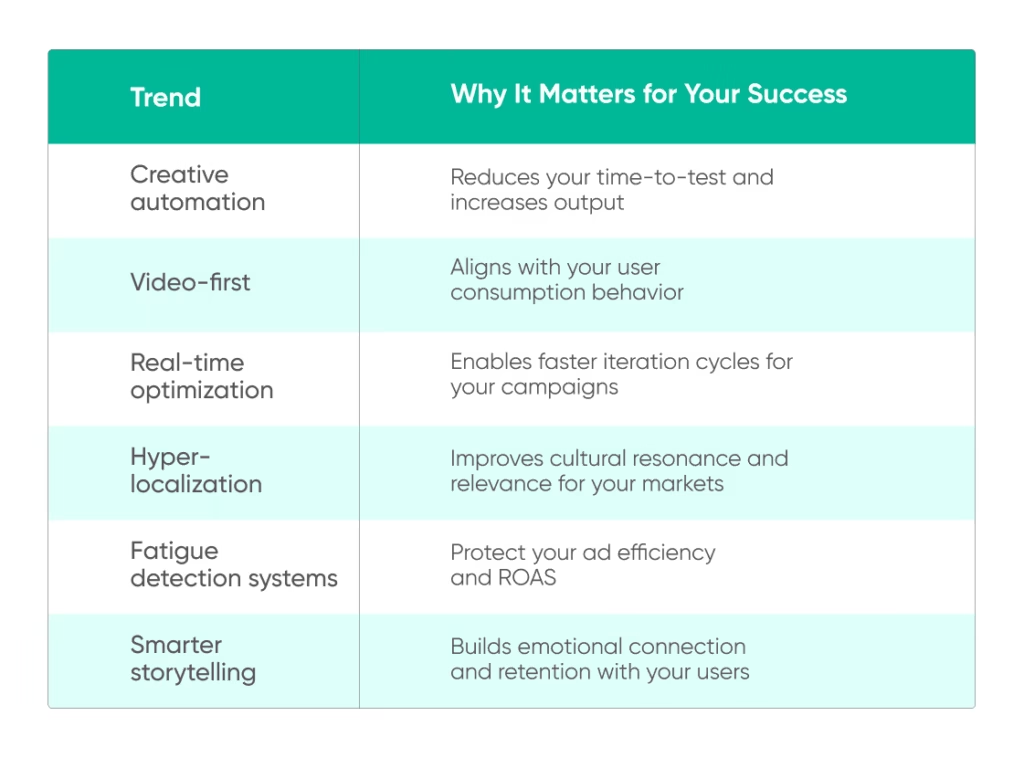
Your mobile marketing isn’t just about “more creatives” — it’s about better systems for creative learning. The teams that win tomorrow are the ones building those systems today, just like you should be doing.
Ready to turn these trends into your real strategy?
In the next section, we’ll give you a step-by-step action plan to upgrade your creative workflows — from audits to testing loops to integration tools that make creative excellence scalable for your campaigns.
Let’s help you go from ideas to impact.
Platform-Specific Deep Dives: iOS vs Android Creative Strategies
No two mobile platforms are the same, and honestly, neither are their creative ecosystems. You’ve got Apple with their privacy-first approach on one side, and Google’s automation-heavy user acquisition model on the other. If you want to win today, you’re playing a two-sided game whether you like it or not.
Here’s the thing: winning on both iOS and Android means you need to understand what creative types, signals, and feedback loops each system actually values. Then you adjust your strategy accordingly. Sounds simple, right? Well, it’s not — but it’s definitely doable once you know what you’re dealing with.
iOS Creative Trends: Signal-Poor, Creative-Rich
The SKAN Reality Check
Let’s be real for a second. SKAN fundamentally changed the game for iOS advertisers, and probably not in the ways you expected when Apple first announced it. With severely limited access to user-level data, your creative has literally become the strongest performance lever you have left.
Think about it this way: when you can’t rely on granular targeting to find the right people, you better make damn sure your message is absolutely compelling to everyone who sees it. You’re basically marketing with a blindfold on, so every single creative needs to work harder than it ever has before.
What’s Actually Working on iOS Right Now
Here’s what the data from 10 million SKAN postbacks across gaming and fintech apps is telling us: the top creatives had 30% stronger install intent scores than the median creative in the same campaign group. That’s not just a small difference — that’s literally the difference between profitable campaigns and budget-draining disasters that keep you up at night.
iOS Creative Champions:
Short-form vertical video (15 seconds max) — These absolutely dominate ASA and social placements because they feel native to how people actually use their phones. The key here isn’t feature lists that make you sound like a robot. Instead, focus on lifestyle benefits. Show someone’s day getting better because of your app, don’t try to explain how your algorithm works.
Static ads with bold, direct copy — End cards with crystal-clear CTAs are seeing higher engagement rates than ever before. Think one powerful headline plus one irresistible offer. You don’t need a fancy design that took your team weeks to create — just clarity and urgency that cuts through all the noise people deal with every day.
Benefit-first messaging that answers “what’s in it for me?” — This consistently outperforms feature-first messaging on iOS, and it’s not even close. Users don’t care about your technical capabilities or how many engineers you have working on the backend. They care about how your app makes their life easier, more fun, or more productive. Period.
High-impact first 3 seconds — There’s absolutely no time for slow narrative builds on iOS. Your hook needs to grab attention immediately, or users will scroll past without giving you a second thought. The best iOS creatives deliver their core value proposition within the first few seconds, because that’s all the time you get.
SKAN’s Creative Reporting Challenges
Here’s what nobody warns you about with SKAN: it tells you that a creative worked, but it doesn’t tell you why it worked. This makes your creative strategy way more important because you’re essentially flying with partial visibility at best.
Your iOS creative approach needs to be built around three key realities that you can’t ignore:
Redundancy is essential – Always have backup creative variants ready to deploy before your current ones hit fatigue. When performance drops on iOS, you need to move fast because the data to diagnose problems comes slowly, and waiting around will kill your campaigns.
Simplicity wins – SKAN only allows limited campaign IDs, so use clear, logical naming conventions that actually help you understand performance patterns. Fancy creative names might be fun for your internal Slack channels, but they’re completely useless when you’re trying to analyze what worked at 2 AM.
Patience is required – SKAN postbacks take time to arrive, so you need to build your creative testing cycles around delayed insights. Don’t panic and make changes after one day of data, like your instincts are telling you to do. Give your creatives time to accumulate meaningful signals.
iOS Creative Performance Breakdown
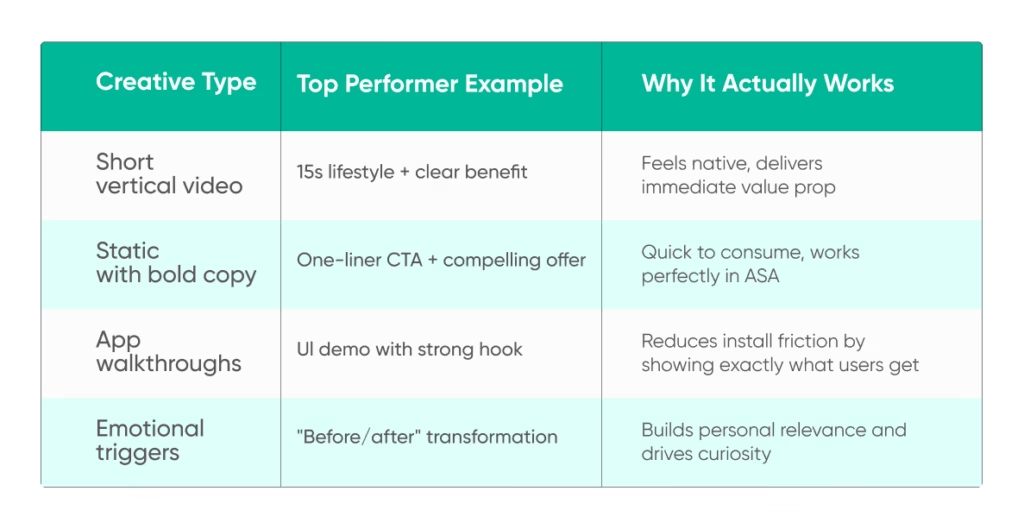
Android Creative Strategy: Rich Signals, Smart Algorithms
The Google App Campaigns Advantage
If iOS is signal-poor, then Android is signal-rich — but only if you actually know how to use that feedback effectively. With Google App Campaigns (UAC), your creatives get auto-optimized across Search, Display, YouTube, and Play Store placements. You’re not controlling targeting directly, but you can heavily influence performance through smart asset-level inputs.
This is like having a really intelligent assistant who can execute your strategy perfectly, but only if you give them the right materials to work with. Give them garbage, and you’ll get garbage results.
Android’s Winning Creative Formula
According to Google’s own research (and they should know), campaigns using at least one video + one static + one HTML5 asset saw higher installs and better in-app actions compared to campaigns with only one format type. The platform literally rewards diversity and gives the algorithm multiple options to optimize with.
Android Creative Power Players:
Multi-asset bundles perform consistently: Static + video + HTML5 combinations give Google’s machine learning system multiple options to test across different placements and user types. The algorithm figures out what works where, but you need to provide quality options for it to choose from.
Playable ads drive serious pre-install intent: These are especially powerful in gaming, but they’re increasingly effective for other app categories too. When you let users “try before they buy,” you’re pre-qualifying intent and typically getting higher-quality installs that actually convert.
Local language variants are crucial: In multilingual markets, having native-language creative variants can dramatically improve performance. Google’s system will automatically serve the right language to the right users, but you need to provide those assets first.
Ad group-level learning drives optimization speed: The more creative variety you provide within themed ad groups, the faster Google’s system learns what resonates with different user segments. It’s like feeding a smart machine more data to make better decisions.
The Power of Android’s Feedback Loops
Google’s machine learning engine handles heavy lifting, but your job isn’t passive. Smart UA teams influence outcomes by understanding how to feed the system effectively:
Test creative bundles regularly: Weekly or bi-weekly rotation keeps the algorithm learning and prevents performance stagnation. Fresh creative inputs give the system new variables to optimize around.
Tag assets with clear, logical naming: Use descriptive names like “Video_Hook_V1” vs “Video_Hook_V2” so you can actually analyze what’s working when you review performance reports.
Use placement reports strategically: Google shows you where your creatives perform best across their network. Use this data to understand which assets work in which contexts, then create more of what’s working.
Refresh creatives every 10-14 days: This prevents the algorithm from getting stuck optimizing around stale assets and keeps your campaigns learning efficiently.
Remember: Google will favor high-performing assets regardless of your personal preferences or what you think looks cooler. Your job is to guide the machine with smart, creative inputs, not fight its optimization decisions.
Platform Comparison: What’s Different, What’s Universal
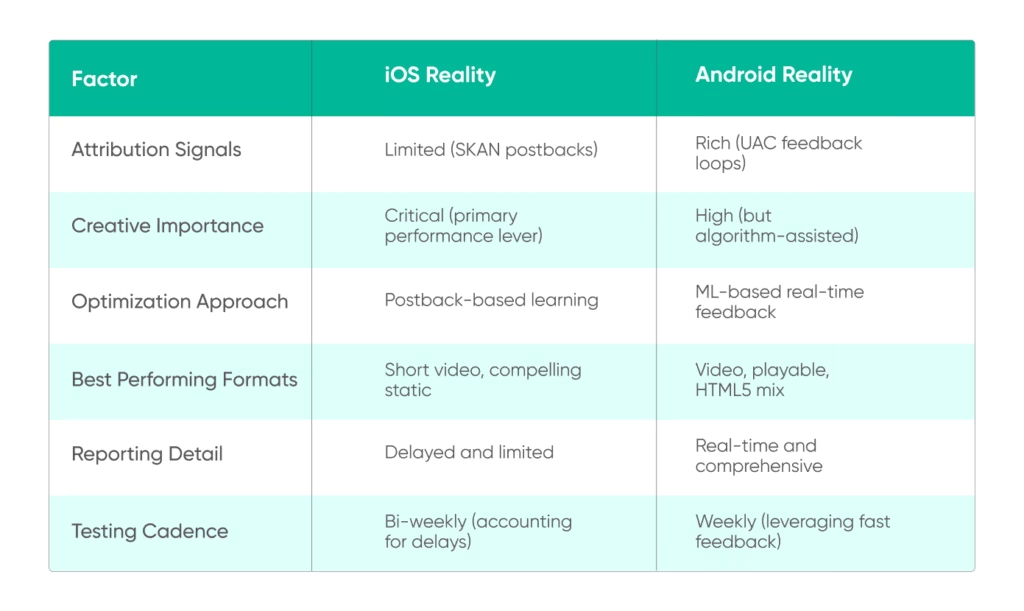
Your Cross-Platform Action Plan
Avoid the Copy-Paste Trap
The biggest mistake teams make is using identical creatives across both platforms because “it’s more efficient.” This approach ignores fundamental differences in how each platform’s users behave and how each algorithm processes creative signals.
Instead, develop platform-specific tactics within your unified creative strategy:
Map creative types to platform strengths – Playables work great on Android’s diverse placement network, while video-first approaches dominate iOS social feeds.
Separate your asset reporting by platform – SKAN postbacks and Google Ads metrics measure completely different things. Don’t try to compare them directly because you’ll just confuse yourself. Understand what each tells you about performance.
Sync your creative refresh cycles appropriately – Weekly Android rotation based on real-time feedback, bi-weekly iOS testing, accounting for SKAN reporting delays.
Platform-Specific Implementation
For iOS Success:
- Develop creatives that work without targeting assistance
- Focus intensely on the first 3 seconds of any video content
- Build redundancy into your creative pipeline for quick pivots
- Accept delayed insights and plan testing cycles accordingly
For Android Excellence:
- Create diverse asset packages for algorithm optimization
- Leverage UAC’s real-time feedback for rapid iteration
- Don’t fight Google’s optimization – work with it strategically
- Use placement performance data to inform creative decisions
For Cross-Platform Coordination:
- Maintain a flexible, creative development process
- Adapt execution tactics to each platform’s requirements
- Share learnings between platforms to improve the overall strategy
- Allocate resources based on platform-specific performance drivers
The Reality Check
Platform mastery means creative agility, not creative uniformity. What works brilliantly in Apple’s privacy-focused ecosystem might not even load properly in a Google UAC bundle. And what scales beautifully on Android might completely underdeliver on iOS without SKAN-specific optimization.
You don’t need two completely separate creative strategies that require separate teams and budgets. You need one intelligent, insight-driven process with platform-specific tactics built into the execution. The teams that win are the ones who understand that iOS and Android reward different approaches, then build systems that can excel at both.
The future of mobile app marketing isn’t about choosing between platforms — it’s about being strategically excellent on both, in completely different ways.
Action Plan: How to Level Up Your Creative Strategy
You’ve seen the trends. You’ve looked at what’s working (and what’s definitely not). Now it’s time to translate those insights into a strategic action plan that’s both structured and flexible, because in mobile UA, agility wins every single time.
Here’s your step-by-step roadmap to building a smarter, more resilient, and higher-performing creative strategy across iOS and Android.
Step 1: Audit Your Current Creative Stack
Before you start optimizing anything, you need to honestly know what you’re working with. Take a hard look at your current setup and be brutally honest about what you find.
Ask yourself these questions:
- How many creatives are you actively using per platform?
- Are your assets diversified across formats (Video, Static, playable)?
- Do you have channel-specific variants (Meta vs ASA vs UAC)?
- Is your creative library organized and versioned properly?
Use this audit to identify what’s gone stale, what’s underperforming, and where your biggest gaps are. You might discover you’ve been running the same three creatives for six months, or that you’re missing playable ads entirely on Android. Both of those discoveries would be pretty typical, honestly.
Step 2: Build a Repeatable Creative Iteration Loop
High-performing teams don’t treat creatives as one-and-done assets that they create once and forget about. They work in continuous cycles of test — learn — optimize. The key word here is “continuous” — this isn’t something you do once a quarter when someone remembers.
Here’s a simple loop to start with:
- Test new creative every 10-14 days (even one asset is a start)
- Measure impact by channel and platform
- Feed results into your brief (what worked, what didn’t)
- Create 2-3 variations of the top performers
- Refresh your bundles before fatigue sets in
Step 3: Test Smarter, Not Just More
Throwing 10 assets into a campaign and hoping the algorithm sorts it out? That’s not testing — that’s guessing. And guessing is expensive, especially when you’re spending real money on real campaigns.
Instead, focus on structured testing:
- Run A/B with a single variable change (hook, CTA, format)
- Focus on intent-driving metrics like CTR, CVR, IPM- not just installs
- Use statistical thresholds (like 90% confidence) before calling winners
- Pay attention to placement-level data, especially on Meta and TikTok
Here’s what most people miss: creative fatigue happens faster than you think it will. Track it weekly using a custom dashboard. If CTR drops by more than 15% week over week, it’s time to refresh — don’t wait for your CPA to spike because that’s when you’re already losing money.
Step 4: Localize Creative for Impact
One size rarely fits all, especially across different regions and cultures. Localizing your creative isn’t just about translating copy from English to Spanish. It’s about matching tone, imagery, and cultural references that actually resonate with people in those markets.
Consider these elements:
- Country-specific pricing visuals
- Regionally popular influencers or slang
- UX/UI language in demo videos
- Holidays and seasonal trends
Apps that localize creatives for their top regions see higher CVR compared to global generic creatives. That’s not a small lift — that’s literally the difference between a good campaign and a great one that your competitors will be jealous of.
Step 5: Assemble Your Creative Optimization Toolkit
Great strategies are powered by the right tools. You don’t need everything on day one, but it helps to have the basics in place so you’re not flying blind — this breakdown on core app install strategies offers a helpful starting point if you’re setting things up.
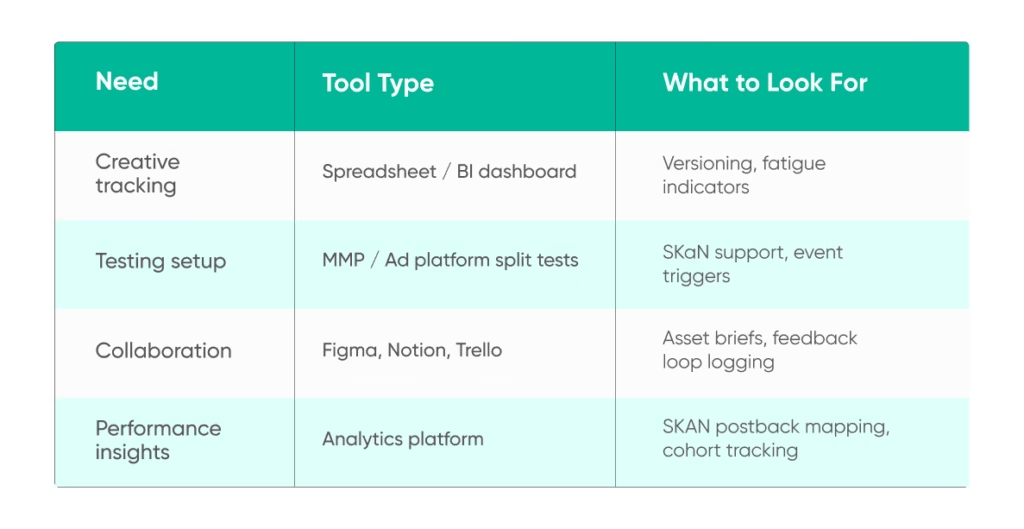
Final Checklist: Launch With Confidence
Before your next campaign goes live, run this quick health check:
- Clear creative brief tied to KPIs
- Format diversity across platforms
- Testing plan with timelines
- Asset naming conventions applied
- Localization checklist completed
- Measurement tools connected
- Fatigue tracking system in place
Bottom line? There’s no silver bullet, but there absolutely is a smart system. When you treat creatives like data-powered assets, not just pretty ads that look good in your portfolio, you start building real momentum. One test at a time.
The teams that win consistently are the ones who understand that creative optimization is a process, not a project you finish and move on from. Build the system, trust the process, and let the results compound over time. That’s how you actually win in mobile UA.
